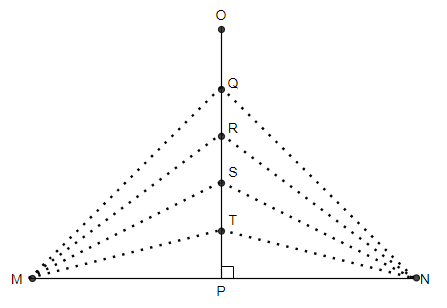
Answer
401.4k+ views
Hint: For solving this question you should know about the perpendicular bisector theorem. According to the definition of perpendicular bisector theorem, if a line divides another line segment into two equal halves, through its midpoint at ${{90}^{\circ }}$, it is known as the perpendicular bisector of that line segment. And the theorem states that any point on the perpendicular bisector is equal from the end points of the line segment.
Complete step-by-step solution:
According to our question we have to give an example of a real application of perpendicular bisector theorem. As we know that if any lines divide the other line into two equal halves or at the midpoint of that line at an angle of ${{90}^{\circ }}$, then it is known as the perpendicular bisector of that line segment. And the perpendicular bisector theorem states that all the points at the perpendicular line are always equal to both end points of this line.

Perpendicular bisector theorem

In this figure
MT = NT
MS = NS
MR = NR
MQ = NQ
If we see the real life example of perpendicular bisector theorem, then we can see the volleyball net at any beach. The figure of that would be like this:

So, according to the diagram it is clear that the pole of the volleyball at the beach is standing with the help of ropes AB = AC and BD = CD. And by measuring we can see that AC and CD and AB and BD have equal lengths, which implies the perpendicular bisector theorem.
So, the example for a perpendicular bisector theorem is a volleyball net’s pole at the beach.
Note: If we see the diagram of perpendicular bisector theorem, then it is clear that we can also calculate the length of the pole if this is not given. And if the question asks to calculate the length of the arms, then all of these can be calculated by Pythagoras theorem which is ${{x}^{2}}={{y}^{2}}+{{z}^{2}}$.
Complete step-by-step solution:
According to our question we have to give an example of a real application of perpendicular bisector theorem. As we know that if any lines divide the other line into two equal halves or at the midpoint of that line at an angle of ${{90}^{\circ }}$, then it is known as the perpendicular bisector of that line segment. And the perpendicular bisector theorem states that all the points at the perpendicular line are always equal to both end points of this line.

Perpendicular bisector theorem

In this figure
MT = NT
MS = NS
MR = NR
MQ = NQ
If we see the real life example of perpendicular bisector theorem, then we can see the volleyball net at any beach. The figure of that would be like this:

So, according to the diagram it is clear that the pole of the volleyball at the beach is standing with the help of ropes AB = AC and BD = CD. And by measuring we can see that AC and CD and AB and BD have equal lengths, which implies the perpendicular bisector theorem.
So, the example for a perpendicular bisector theorem is a volleyball net’s pole at the beach.
Note: If we see the diagram of perpendicular bisector theorem, then it is clear that we can also calculate the length of the pole if this is not given. And if the question asks to calculate the length of the arms, then all of these can be calculated by Pythagoras theorem which is ${{x}^{2}}={{y}^{2}}+{{z}^{2}}$.
Recently Updated Pages
If the coordinates of the points A B and C be 443 23 class 10 maths JEE_Main

If the mean of the set of numbers x1x2xn is bar x then class 10 maths JEE_Main

What is the meaning of celestial class 10 social science CBSE

What causes groundwater depletion How can it be re class 10 chemistry CBSE

Under which different types can the following changes class 10 physics CBSE

Article 46 of the Constitution of India refers to the class 10 social science CBSE

Trending doubts
Fill the blanks with the suitable prepositions 1 The class 9 english CBSE

Which are the Top 10 Largest Countries of the World?

How do you graph the function fx 4x class 9 maths CBSE

Find the value of the expression given below sin 30circ class 11 maths CBSE

The Equation xxx + 2 is Satisfied when x is Equal to Class 10 Maths

Differentiate between homogeneous and heterogeneous class 12 chemistry CBSE

Change the following sentences into negative and interrogative class 10 english CBSE

Difference between Prokaryotic cell and Eukaryotic class 11 biology CBSE

Why is there a time difference of about 5 hours between class 10 social science CBSE




